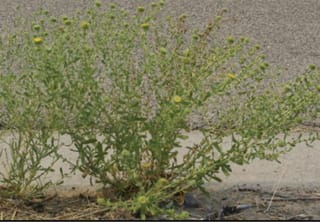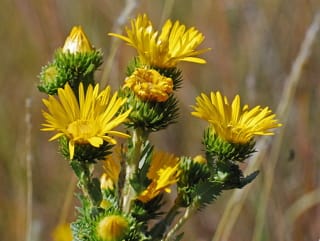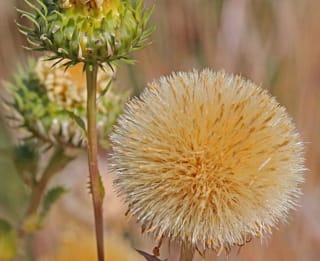This guide initially displays all weeds in the Los Alamos area classified in NM as noxious regardless of shape. Use the selectors below to include nonclassified weeds or select a specific set, either by shape or name.
The term weed is commonly used to denote a plant that is growing in an area where it is not valued. It is officially defined by the USDA Animal and Plant Health Inspection Service as being any plant that poses a threat to agriculture and/or a natural ecosystem. A noxious weed is one that is particularly troublesome and can directly or indirectly injure or cause damage to crops, livestock, or natural resources.
In general, plants that are within their native range live in balance with their environment and are not typically considered to be weeds. Issues can occur, however, if a plant is introduced, either directly or indirectly, to a new ecosystem. These, now non-native plants, may be able to thrive in their new environment. If so, these naturalized plants can fall into one or two categories long term: (1) plants that are valued for their flowers and fruit and (2) plants that are rapidly considered to be weeds. The plants in the latter category are those that are generally regarded as noxious weeds.
While some species shown here are included in the PEEC Flower and Tree Guides, this guide concentrates on some of the nastier introduced species that you might see in your yard or on local trails. In addition, this guide includes some native plants that meet the general definition of weed.
Weed References
A Plan For the Control of Invasive Species on Los Alamos County Open Space — Craig Martin [PDF]
Los Alamos Master Garden Weed List
NMSU Weed Information
SEINet: Southwest Biodiversity
Some Common Lawn and Garden Weeds of Los Alamos, NM — Dorothy Hoard and Teralene Foxx [PDF]
Troublesome Weeds of NM
USDA: Introduced, Invasive, and Noxious Plants
Weed Alert
Weeds of the Los Alamos Area — Teralene Foxx [PDF]
Subject Area Experts (all guides)
Steve Cary (butterflies)
Beth Cortright (insects)
Terry Foxx (invasive plants)
Leslie Hansen (mammals)
Richard Hansen (fish, mammals)
Dorothy Hoard (butterflies, trees)
Chick Keller (flowers, herbarium)
Shari Kelley (geology)
Kirt Kempter (geology)
Garth Tietjen (reptiles)
David Yeamans (birds)
Web Development and Content Management
Pat Bacha
Jennifer Macke
Graham Mark
Akkana Peck
Contact
Please contact us for local nature questions and sightings. We welcome comments, corrections, and additions to our guides.
For more information about local nature, please visit our Nature Blog or subscribe to PEEC This Week.
Make Selection
 Photo: Jerry Friedman  Photo: Jerry Oldenettel  Photo: Jerry Oldenettel |  Curlycup Gumweed, Curly-cup Gumweed, Rosinweed, TarweedGRSQ (Grindelia squarrosa)Family: Asteraceae (Daisies) Size: up to 40 in (102 cm) Growth: forb/herb; annual, biennial, perennial Status: native; nonclassified Native Range: western and southwestern North America NM Noxious Weed Class: not classified Habitat: disturbed areas, often along roadsides and streams Control Notes: digging the plants up for small areas, in particular management of the edges of an infestation works best; herbicides are partially effective Curlycup Gumweed has straw-colored to reddish stems with gray-green, crenate leaves. The leaves have a yellow bump near the tip of each tooth. It produces a large number of flower heads with yellow blooms that open late in the year. The bracts exude a sticky resin that has been chewed like chewing gum. Although the plant will spread under favorable conditions, it does not pose any environmental concern to native plants under proper management. However, due to its ability to invade disturbed sites, it is often associated with other rangeland weeds. Curlycup Gumweed is particularly attractive to native bees. The flowers and leaves were used by several different tribes of Native Americans as a medical herb. However, the plant concentrates selenium which means it can become toxic when eaten by mammals. In general, cattle and horse find the plant unpalatable, though sheep will eat the flowers. Curycup Gumweeds is being tested as a biofuel due to it high content of several chemicals that can be converted to compounds analogous to kerosene. Info Photos Distribution Flower Guide |
